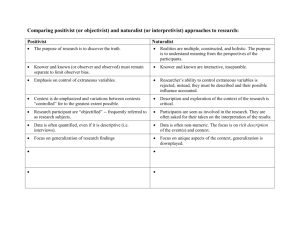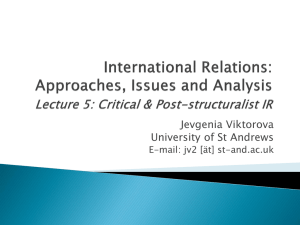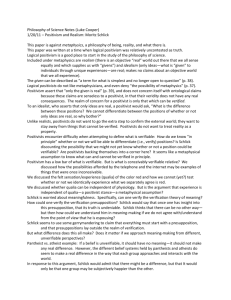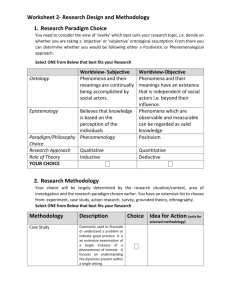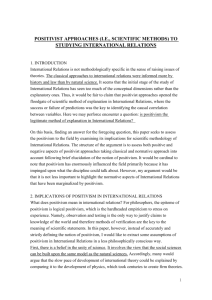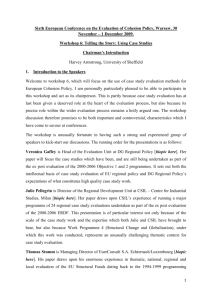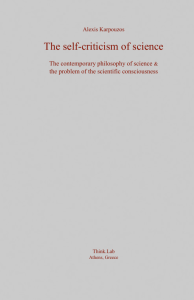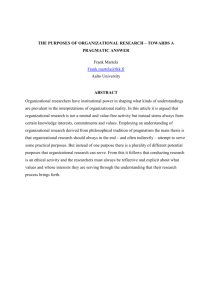situations rather
advertisement
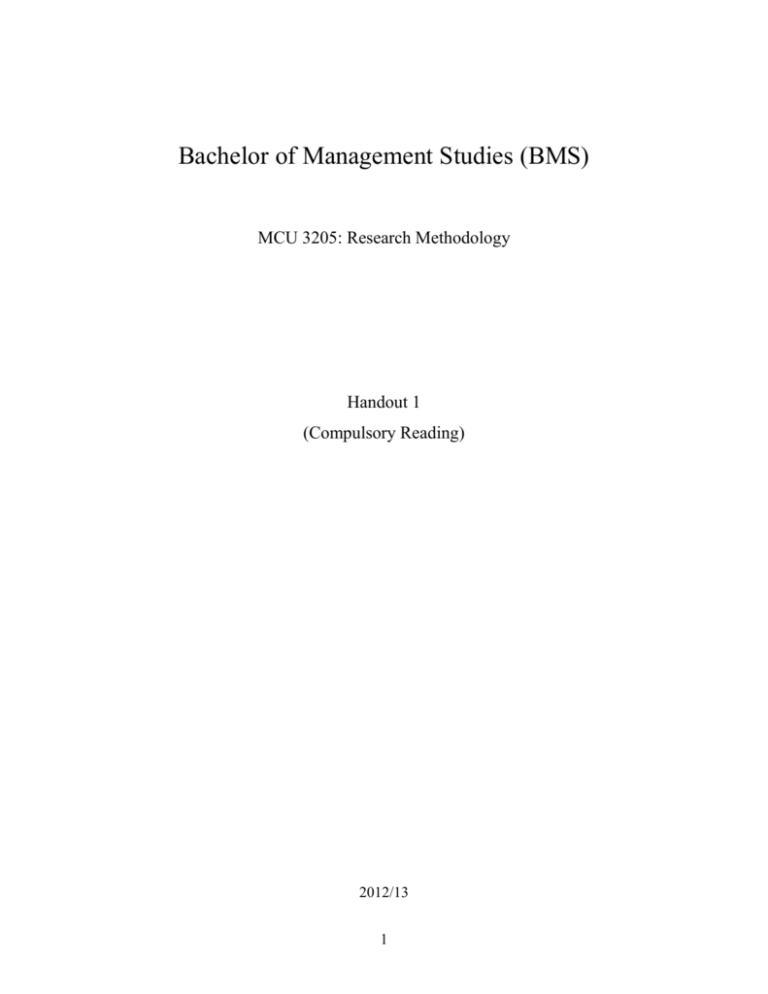
Bachelor of Management Studies (BMS) MCU 3205: Research Methodology Handout 1 (Compulsory Reading) 2012/13 1 THE PHILOSOPHY OF RESEARCH DESIGN Two main traditions There is a long-standing debate in the social sciences about ht most appropriate philosophical position from which methods should be derived. In the red corner is post positivism; in the blue corner is positivism. So what are these traditions? Let us start with positivism. The key idea of positivism is that the social world exists externally, and that its properties should be measured through objective methods, rather than being inferred subjectively through sensation, reflection or intuition. The French philosopher, Auguste Comte (1853), was an early and influential proponent of this view, as he said: ‘All good intellects have repeated, since Bacon’s time, that there can be no real knowledge but that which is based on observed facts’. The statement contains two assumptions: firstly, that reality is external and objective; secondly, that knowledge is only of significance if it is based on observations of this external reality. There follow from this a number of implications, although not all of them were proposed by Comte: 1. Independence : the observer is independent of what is being observed; 2. Value - freedom : the choice of what to study, and how to study it, can be determined by objective criteria rather than by human beliefs and interests; 3. Causality: the aim of social sciences should be to identify casual explanations and fundamental laws that explain regularities in human social behaviour. 4. Hypothetic - deductive: science proceeds through a process of hypothesizing fundamental laws and then deducing what kinds of observations will demonstrate the truth or falsity of these hypotheses. 5. Operationalisation: concepts need to be operationalised in a way which enables facts to be measured quantitatively. 6. Reductionism: problems as a whole are better understood if they are reduced into the simplest possible elements; 2 7. Generalization: in order to be able to generalize about regularities in human and social behaviour it is necessary to select samples of sufficient size; 8. Cross - Sectional analysis: such regularities can most easily be identified by making comparisons of variations across samples. It is worth repeating that these propositions are not simply the view of any single philosopher; they are a collection of points that have come to be associated with the positivist viewpoint. The view that positivism provides the best way of investigating human and social behaviour originated as a reaction to metaphysical speculation (Aiken, 1956). This philosophy has developed into a distinctive paradigm over the last one and a half centuries. The term ‘paradigm’ has come into vogue among social scientists recently, particularly through the work of Thomas Kuhn. Kuhn (1962) used it to describe the progress of scientific discoveries in practice, rather than how they are subsequently reconstructed within text books and academic journals. Most of the time, according to Kuhn, science progresses in tiny steps, which refine and extend what is already ‘known’. But occasionally experiments start to produce results that do not fit into existing theories and patterns. Then, perhaps many years later, a Galileo or Einstein proposes a new way of looking at things which can account for both the old and the new observations. It is evident from these examples, that major scientific advances are not produced by a logical and rational application of scientific method. They result from independent and creative thinking which goes outside the boundaries of existing ideas. The result of this is a ‘scientific revolution’ which not only provides new theories, but which may also alter radically the way people see the world, and the kind of questions that scientists consider important to investigate. The combination of new theories and questions is referred to as a new paradigm. 3 The new paradigm that has arisen during the last half century, largely in reaction to the application of positivism to the social sciences, stems from the view that the world and ‘reality’ are not objective and exterior, but that they are socially constructed and given meaning by people (Husserl, 1946). The starting point, as we have said, is the idea that reality is socially constructed rather than objectively determined. Hence the task of the social scientist should not be to gather facts and measure how often certain patterns occur, but to appreciate the different constructions and meanings that people place upon their experience. One should therefore try to understand and explain why people have different experience, rather than search for external causes and fundamental laws to explain their behaviour. Human action arises from the sense that people make of different situations, rather than as a direct response from external stimuli. The implications of holding these different views may be seen, for example, in the way researchers might study managerial stress. The social constructionist would be interested in the aspects of work that managers consider to be ‘stressful’, and perhaps in the strategies that they develop for managing these aspects. He/she would therefore arrange to talk with a few managers about their jobs, about the aspects they find more, or less, difficult, and so on. The positivist, on the other hand, would start with the assumption that occupational stress exists and might they try to measure the levels of stress experience by managers and how these relate to a number of external stressors such as organizational changes, interpersonal conflicts, negative appraisal, and so on. Measures of stress could be based on standardized verbal reports from the managers, or on physiological factors such as blood pressure or glandular secretions. Within the post positivist viewpoint there are several direct attacks on the assumptions of positivism. One is the notion of ‘scientism’ (Keat, 1981), which holds that the only knowledge of any significance is that which is derived from the use of objective measures. Another is the view that science itself should be based only on data that can be observed and measured directly. But one of the strongest attacks on positivism has been on its assumptions of value-freedom. This is argued most strongly by Habermas (1970), who 4 points out that any form of knowledge is an instrument of self-preservation. Human interests not only guide the way we think, and the structures of work and authority, but they condition the way we enquire into, and construct our knowledge of, the world. One of the big problems with positivist methods is that they are claimed to be independent of values and interests, yet by and large they support, in practice, the interests of the more powerful members of society. Habermas thus attempts to demonstrate the true relationship between knowledge and interest which is otherwise concealed by the objectivist views of positivism. In Figure 3.2, we attempt to summarize the main differences between the positivist and the post positivist viewpoints. Basic beliefs: Positivist paradigm Post positivist paradigm The world is external and The world is socially Objective constructed and subjective Observer is independent Observed is part of what is observed Science is value-free Science is driven by human Interests Researcher focus on facts focus on meanings look for causality and try to understand what is fundamental laws. happening reduce phenomena to look at the totality of each simplest elements situation Formulate hypotheses and develop ideas through then test them induction from data Should 5 Preferred methods operationalising concepts using multiple methods to Include so that they can be measured establish different views of phenomenon Taking large samples small samples investigated in depth or over time. Different paradigms – Examples of practice These are the studies of Pugh and his colleagues at Aston into organizational structure, and the work of Geert Hofstede (1984) on culture. From 1961 onwards, Pugh and his colleagues conducted a number of large-scale studies of organizations in the West Midlands of England, and in other parts of the world. Their initial, and classic, study involved a sample of 46 organizations with manufacturing or service operations in Greater Birmingham, each one employing at least 250 people. Organizations were selected to provide a good range of sizes and product types. The researchers used a highly structured interview schedule in order to gather data on a total of each organization. From an analysis of the data across their sample they were able to come up with a number of general conclusions, for example, that size is the most important determinant of organizational structure, and that organizations which are closely dependent on other organizations tend to centralize as many decisions as possible. These studies achieved international fame when the results were written up in a series of articles that appeared in Administrative Science Quarterly, and which were subsequently collected together in a book (Pugh and Hickson, 976). Possibly their main significance is the way they highlight the authority structures within organizations as key factors to consider when attempting to change, or understand , organizational behaviour. Pugh (1988) feels that this provides a useful counterbalance to the prevailing emphasis on individual and grouprelated factors. 6 In a separate account of the ideas and methods behind this work, Pugh (1983) describes himself as an ‘unreconstructed positivist’. The key principles that the applies to his work include: focusing on hard data rather than opinions; looking for regularities in the data obtained; and attempting to produce propositions that can generalize from the specific example to the wider population of organizations. He states his view that factors and values can be clearly separated, a view that would of course be hotly disputed by Habermas; but he also adopts a ‘systems’ view which attempts to examine the full complexity of the data, rather than simply reducing it to its simplest elements. This latter point is perhaps a modification of the positivist view which has arisen partly as a result of developments in the biological sciences (Von Bertlanffy, 1962), and partly as a result of the ability of modern computers to conduct very sophisticated multi-variate analysis of data, provided it is expressed in quantitative terms. Thus, Pugh, by his own admission, sticks fairly closely to the positivist paradigm described above, although in his own research programme he also found it necessary to conduct more detailed case studies of individual organizations in the later stages of his research in order to give a fuller understanding of what was taking place inside (Pugh, 1988). The second example of positivist research is the classic study of Hofstede(1980) into the effect of national cultures on social and work behaviour. This was based on 116,000 questionnaires completed between 1967 and 1972 by employees of a large American multinational. Hofstede’s data was totally quantitative and its analysis was conducted purely by computer. This analysis indicated four dimensions of national culture: 1. individualism: whether a society emphasizes in individual autonomy as opposed to responsibility to the group; 2. masculinity: how far roles in society are differentiated between men and women. 3. Power distance : the extent to which inequality is accepted by the less powerful people in society; 4. uncertainty avoidance : the level of concern about law and order in a society. 7 Each of these dimensions was statistically independent in the sense that a high score on one would imply neither a high nor a low score on any of the other dimensions. Hofstede, as the researcher, was also distanced and independent from the respondents of the questionnaires. Thus far, Hofstede’s highly quantitative research appears to conform closely to the positivist paradigm. Beyond that, based on his account of the research process (Hofstede, 1980), much of his work simply does not fit the positivist paradigm. For example, he accepts that he is dealing with mental constructs rather than hard objective facts. The four main dimensions of national culture were not formulated as initial hypotheses but only after considerable post hoc analysis of the data, and through much reading and discussion with other academic colleagues. Thirdly, he is fully aware of the importance of avoiding assumptions about culture which imply that any one culture is superior to another; and therefore he accepts that his results are not necessarily value-free. Fourthly, he recognizes that different methods will provide different perspectives on what is being studied, and therefore it is worth ‘triangulating’ where possible by using a combination of both quantitative and qualitative methods. Thus, in practice, Hofstede’s work contains elements of both paradigms. On the side of social constructionism is the work of Melville Dalton (1959), who carried out one of the pioneering studies of what managers do in practice. In a later paper (Dalton, 1964) he describes the ideas and philosophies that guided his work, plus some of the ethical dilemmas that were encountered. For a start Dalton rejects the classical ‘scientific method’ as inappropriate to his work (this is the sequence of hypothesis, observation, testing, and confirmation or disconfirmation of hypothesis). He points out that not only is this method rather idealistic in the sense that natural scientists do not usually follow it themselves (except in the school laboratory), but it was also not feasible to use it in the situation he has chosen. He is opposed to the tendency to quantify and to reduce variables to their smallest components, on the grounds that this loses most of the real meaning of the situation. Dalton studied the behaviour of managers while working himself within on organization as a manager. Curiously enough, although he is quite open about his methods and some of the dilemmas this caused, he does not actually say what his role was in the group, but it allowed 8 him ‘much unquestioned movement about the firm’ While working in the company he gathered data from his own observations and from those of a number of informants. The informants were clearly aware to some extent of Dalton’s purposes but the rest of the people in the company were largely ignorant what he was doing - his role was therefore partly overt and partly covert. This clearly meant that he was not in a position to establish any formal experiments to test his ideas, although curiously enough he comments that some of his informants who were aware of his general purpose occasionally deliberately set up situations for him to observe. Thus in no way was Dalton an independent observer of what was taking place; his presence certainly has some impact or the company, even though the nature of that impact is one of the things about which Dalton does not speculate greatly. Although much of his data was qualitative, in the form of observations by him and comments from his informants, he was not averse to collecting a certain amount of quantitative data such as details of the salaries of managers in the company. This he obtained informally from a secretary in the personnel department in exchange for counseling about whether or not she should marry her boyfriend (in the end she married him, despite Dalton’s counseling !) It is quite clear that Dalton did not start the research with any clearly preconceived set of hypotheses and theories to test; his research grew out of his own ‘confusions and irritations’. Rather than trying to formulate explicit hypotheses and guides for his work, he contented himself with framing simple questions about things were taking place which he did not clearly understand. After looking at a number of specific topics such as the reasons for conflict between different groups of people or the way people accounted for the success of some managers, he finally settled on the overall scheme of attempting to understand the distinctions and relationships between official and unofficial action within the organization. Dalton was also aware that looking at only one organization in depth could limit the generalisability of his conclusion. So he supplemented his work with studies through other contacts of several other organizations in the same area. That at least gave him the confidence that the things he observed in his own company. Milo, were quite likely to be taking place n most other companies, at least in that part of the Unites States. 9 The above studies are often sited as relatively pure examples of positivist and post positivist approaches. The distinction between these two approaches is very clear at the philosophical level (Burrell and Morgan (1979). Before we leave the discussion of how these two paradigms may underlie practical examples, it is worth summarizing from a pragmatic view what are seen as some of the strengths and weaknesses of each side. This should help the researcher to choose which methods and aspects are most likely to be of help in a given situation. In the case of quantitative methods and the positivist paradigm, the main strengths are that they can provide wide coverage of the range of situations; they can be fast and economical; and, particularly when statistics are aggregated from large samples, they may be of considerable relevance to policy decisions. On the debit side, these methods end to be rather inflexible and artificial; they are not very effective in understanding processes or the significance that people attach to actions; they are not very helpful in generating theories; and because they focus on what is, or what has been recently, they make it hard for the policy-maker to infer what changes and actions should take place in the future. As Legge (1984) points out, they may only provide illusions of the ‘true’ impact of social polices. Most of the data gathered will not be relevant to real decisions although it may be used to support the covert goals of decision-makers. The strengths and weaknesses of the post positivist paradigm and associated qualitative methods are fairly complementary. Thus they have strengths in their ability to look at change processes over time, to understand people’s meanings, to adjust to new issues and ideas as they emerge, and to contribute to the evolution of new theories. They also provide a way of gathering data which is seen as natural rather than artificial. There are of course, weaknesses. Data collection can take up a great deal of time and resources, and the interpretation of data may be very difficult. Qualitative studies often feel very untidy because it is harder to control their pace, progress and end-points. There is also the problem that many people, especially policy-makers, may give low credibility to studies based on a post positivist approach. Adopted from: Management Research - An Introduction by Mark Easterby- Smith, Richard Thrope and Andy Low 10 11
